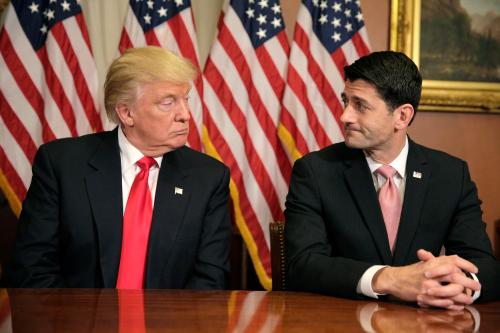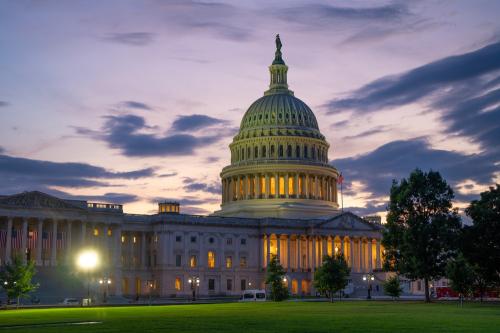Republican leaders have convinced themselves that the way to enact tax reform is through tight party discipline and little input from the minority party. That hasn’t worked too well so far on replacing Obamacare of course. Nevertheless, the strategy does fit the generally accepted view – in Congress, at the White House, and among the public – that because Congress is so polarized and partisan these days, lawmaking is always going to be a winner-takes-all process.
But that presumption turns out to be plain wrong. Recent research by Frances Lee of the University of Maryland, and James Curry of the University of Utah, shows the reality to be a very different pattern of lawmaking. Comparing congresses right back to 1973, they found that if you look at laws actually passed in recent years – as opposed to “messaging” votes and other legislative noise – there is a quite consistent pattern of strong minority party support for bills that became law.
That is true as well for landmark legislation, where the degree of minority support is actually higher. It is also true of the majority party’s top agenda items. And perhaps most surprising of all, it is true for recent congresses, despite the common view that completed lawmaking is more partisan. The fact is: to get legislation across the finish line, the majority still needs solid minority support.
There are of course some exceptions to this general pattern, such as the one-party passage of the Affordable Care Act. However, more typical of the historical pattern was the 2015 “doc fix” legislation to overhaul Medicare payments, as well as the more recent 21st Century Cures Act, a major bill enacted in December 2016, that funds mental health, biomedical research and makes important changes in drug approval rules. These latter laws garnered broad bipartisan support – as did the last sweeping tax reform legislation, in 1986. By contrast, strictly partisan Republican efforts to repeal and replace Obamacare have – so far – failed to become law.
One thing that has changed in recent years is the manner in which bipartisan passage is achieved. Some laws, like the Cure Act, still progress to enactment through the “regular order” of hearings and committee drafting. But party polarization has led to more laws enacted where party leaders and key members after quietly reached across the aisle and explored the possibilities for agreement; Lee and Curry cite the doc fix as a recent example.
In today’s polarized and partisan atmosphere, the research shows that to be successful, legislative leaders need to be more adept in pursuing the indirect approach to achieving a win.
In today’s polarized and partisan atmosphere, the research shows that to be successful, legislative leaders need to be more adept in pursuing the indirect approach to achieving a win. That means courting key groups and constituencies, as well as key majority and minority members. It often means avoiding regular order, where a politically deadlocked committee could stymie passage. Research by Vanderbilt’s Alan Wiseman and University of Virginia’s Craig Volden lends support to this more entrepreneurial vision of lawmaking. They analyzed which House lawmakers are most effective in getting legislation done when compared with others at the same backbench or leadership level. They cite the ability to be entrepreneurial in navigating power centers, a willingness to compromise with those who are not natural allies and to cultivate a wide set of allies as three of the five key habits needed for success in the legislating business. They also discovered that, in general, female lawmakers are more likely to possess these traits and are more bipartisan and effective.
So why has the congressional news industry overlooked this pattern and continued to portray lawmaking as increasingly partisan, when the data on even recent years show otherwise?
One reason is that appearances are deceptive. When the visible, traditional committee system appears deadlocked or more partisan, it obscures the more bipartisan nature of less visible procedures, such as how informal organizations like caucuses often create a vehicle for interparty cooperation and pathways for policy ideas to gain support. It is the on-camera squabbling that dominates the news cycle, however, and gives an exaggerated impression that lawmaking is heavily partisan.
Other research by Frances Lee suggests a second reason for the false impression that laws in recent years typically been pushed through in recent years on party line votes. She points out that, in contrast to the political situation in Congress throughout most of the 20th century, we are today in an unusual period in which control of the Congress is very competitive. Power has changed hands more frequently in recent elections. That causes parties to try to differentiate themselves more sharply to the public. Thus, with an eye on more competitive congressional elections, politicians in both parties refrain from touting the other party’s valuable role in passing laws – even though such bipartisanship is actually the norm.
When it comes to the tax bill, we shall see whether Republican leaders keep in mind that laws have generally been enacted with bipartisan support – even in recent years – and whether President Trump encourages a process of compromise. If they do, then expect quiet negotiations with the Democrats to gain momentum as the tax legislation evolves and moves to the Senate. If they do not, experience suggests that the chances of a tax reform law being passed will decline sharply.
The Brookings Institution is committed to quality, independence, and impact.
We are supported by a diverse array of funders. In line with our values and policies, each Brookings publication represents the sole views of its author(s).





Commentary
Republicans will need to work with Democrats to pass tax reform
November 8, 2017